Suggest a hotel, city or country that you would like us to write about.
Error: Contact form not found.
Suggest a hotel, city or country that you would like us to write about.
Error: Contact form not found.
Sheraton Paris Airport Hotel
Hotel Information: Sheraton Paris Airport Hotel located at the new terminal 2 of the Parisian Charles de Gaule airport- the architects attempted to make the traveller feel at ease, using simplicity to create a luxury based on notions such as coolness, calm, boldness and gaiety rather than nostalgia or attachment to the past. In the warm and spacious lobby the porticoes with their wide vertical stripes extended an informal welcome to various places: bar, reception desk, concierge, kiosk, luggage room and so on. Opposite the entrance a light-filled nacelle leads to the lifts. To the right, the leisure areas: brasserie and restaurant beckon discreetly. People go to their rooms by a pleasant promenade. The parapet in the cloudy, shaded ground galls is topped by an oak handrail. Underfoot, the being carpet is livened up by myriad flecks of irregular blue bubbles. On the walls, sparse, asymmetrically set, back lit ground glass stars serve as light fittings. access to the rooms is by a handsome oak door.
Guests review score: 8/10 (of 323 reviews)
Room Information: 252 rooms.The route to the bedrooms is along corridors that are open to a wide and majestic central atrium. The rooms have an elegant and classical appearance, and are equipped with small and simple conveniences in order to make the guests stay more pleasant. The bathroom is relatively small, and as such it had to be exquisite. The room has a classical aspect, and contains many luxury surprises and user-friendly details.
Rates: from 210 Euro
Hotel Facilities
General Restaurant, Bar, 24-Hour Front Desk, Newspapers, Non-Smoking Rooms, Rooms/Facilities for Disabled Guests, Safety Deposit Box, Soundproofed Rooms, Luggage Storage, Allergy-Free Room Available.
Activities Sauna, Fitness Centre.
Services Room Service, Meeting/Banquet Facilities, Airport Shuttle, Business Centre, Babysitting/Child Services, Laundry,, Currency Exchange, Car Rental, Tour Desk, Fax/Photocopying, Ticket Service.
 Bleibtreu Berlin
Bleibtreu BerlinHotel Information: The Hotel Bleibtreu Berlin is an old town hotel that was converted into a modern hotel with carefully selected art. up to the minute design and the most modern technology. The entrance is flanked by delicatessen and an exclusive florist´s shop, surround guests with pleasant impressions from the moment they arrive. The building opened out into the calm garden of the Mediterranean-style inner courtyard through a series of glasses-in rooms with Italian terrazzo flooring. Distinct colour schemes give each floor its own particular atmosphere. Recurring elements bind the various parts together into a harmonious whole. On the top floor black and white striped patterns predominate, with black, grey and red tiling in the bathrooms. The fourth floor is decorated in warm yellow tones. Strong blue shades are used on the other three floors. Indirect light streams into the rooms, with natural light sources being employed wherever possible. The interior design of the hotel is by Herbert Jakob Weinand, who also organised purchasing of the objects d´art.The interior spaces are wrapped in a warm atmosphere by means of the use of oak, lamps made in Murano glass and the predominated use of and intense blue color, that singularize some specific spaces of the hotel.
Guests review score: 8,3/10 (of 51 reviews)
Hotel Rates: from 94 Euro
Room information: 60 rooms. Two rooms are equipped for the disabled. It is possible to connect for families two rooms with a shared anteroom. ( Buffet breakfast costs EUR 17.00 per person.)
Special: The Wellness Area, offering aroma therapy, colour therapies, steam rooms and Bach flower remedies is the finishing touch to the relaxation offered to guests.
Hotel Facilities:
General Minibar, Shower, Pay TV, TV, Telephone, Radio, Hairdryer, Wake Up Service/Alarm Clock, Work Desk
Activities Massage, Turkish/Steam Bath.
Services Room Service – Laundry – Dry Cleaning – Breakfast in the Room – Currency Exchange – Packed Lunches – Fax/Photocopying
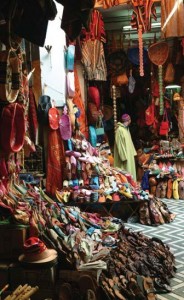 Casablanca: These days when people think of Morocco, they conjure up images of quaint riad hotels set deep in the medina of Marrakech, Meknes or Fès. They think of desert camel rides, of spices laden high on market stalls, of horse-drawn carriages moving through the yellow evening light. Ask someone if they have ever visited the coastal city of Casablanca, and they are likely to stick their nose haughtily in the air and declare, ‘That’s not real Morocco!’ Nothing could be farther from the truth. Without Casablanca (pronounced by locals as ‘Caza’), Morocco would quickly grind to a halt. It’s an economic engine that powers the life in the cities and the mountains, in the deserts and along the shores. I was first drawn to the city because it is so despised by foreigners. Wander the streets or pause in the shaded cafés on the long afternoons, and you won’t ever see a tourist – guaranteed. Casablanca is unwieldy and sprawling, and it keeps up with the times. But it’s built on a bedrock of tradition. Life there is more Moroccan than almost anywhere else. This may sound strange to anyone who knows their history. Although the first community was established by the Phoenicians in the suburb of Anfa, modern Casablanca was built by the French early in the twentieth century. They planned it as a showcase of imperial Gallic architecture – sweeping art deco boulevards lined with palm trees and fabulous villas, avenues of domed apartment blocks, gleaming in the coastal light. But scratch the surface and you find that Casablanca is a melting pot of people, drawn from all corners of the kingdom. Lured by the prospect of work and a good life, Casawis, as they are known, represent almost every hamlet, village, town and city of the country.
Casablanca: These days when people think of Morocco, they conjure up images of quaint riad hotels set deep in the medina of Marrakech, Meknes or Fès. They think of desert camel rides, of spices laden high on market stalls, of horse-drawn carriages moving through the yellow evening light. Ask someone if they have ever visited the coastal city of Casablanca, and they are likely to stick their nose haughtily in the air and declare, ‘That’s not real Morocco!’ Nothing could be farther from the truth. Without Casablanca (pronounced by locals as ‘Caza’), Morocco would quickly grind to a halt. It’s an economic engine that powers the life in the cities and the mountains, in the deserts and along the shores. I was first drawn to the city because it is so despised by foreigners. Wander the streets or pause in the shaded cafés on the long afternoons, and you won’t ever see a tourist – guaranteed. Casablanca is unwieldy and sprawling, and it keeps up with the times. But it’s built on a bedrock of tradition. Life there is more Moroccan than almost anywhere else. This may sound strange to anyone who knows their history. Although the first community was established by the Phoenicians in the suburb of Anfa, modern Casablanca was built by the French early in the twentieth century. They planned it as a showcase of imperial Gallic architecture – sweeping art deco boulevards lined with palm trees and fabulous villas, avenues of domed apartment blocks, gleaming in the coastal light. But scratch the surface and you find that Casablanca is a melting pot of people, drawn from all corners of the kingdom. Lured by the prospect of work and a good life, Casawis, as they are known, represent almost every hamlet, village, town and city of the country.
As a result, the spirit of the place is charged with the best that Morocco has to offer, and it overflows with traditional belief. There is no better way to tap into the underbelly of a place than to renovate a house. It’s a feat of endurance, a love affair that usually begins with a brief encounter. My love affair with Casablanca began when I bought a large rambling villa named Dar Khalifa – literally The Caliph’s House. Perched on the western edge of town, a stone’s throw from the crashing Atlantic waves, it was more than just an empty building. It was a place of mystery, a home with a soul.The three guardians who came with the property, as if by some medieval right of sale, told me that the mansion had lain uninhabited for almost a decade. In Europe, a boarded up house might attract squatters, but in Morocco such a place is a magnate for jinns. Muslims believe that when God created man from clay, He also fashioned another species from smokeless fire. Known as jinns, genies or jnun, these spirit-people live in a parallel world laid atop our own. Like us, they are born, they get married and die;but, unlike man, they can be visible or invisible and can transmute into any form they wish. Through the many dark months of renovation, I explored every corner of the city, in a search for master craftsmen, for antique furniture, and for witches to exorcise the legion of malevolent jinns. The city’s endless suburbs team with skilled people and with objets d’art.
At Ain Chock, I came upon a team of zelijiers, artisans who hand-cut mosaics in a thousand different shapes. In the vast junkyard at Derb Ghalif, I found mountains of architectural salvage from the French era – doorways and stained glass panels, carved bronze doorknobs and exquisite roll top baths. And on an outcrop of rocks in the sea, I happened upon the shrine of the Sufi Saint Abdur Rahman. Clustered there in a honeycomb of rooms live a sorority of witches and clairvoyants, whose sinister skills link them to the underworld. If Casablanca is beneath my feet, I know there’s not going to be a dull moment in the day. But this morning I was introduced to an English businessman who has lived there for three years or more. His face was tired, his shoulders rounded with boredom. He said that the city was a place of tedium, devoid of life. I told him about the junkyards, the witches and the dogs. He wondered if we were talking about the same Casablanca. I smiled because I knew we were. Sometimes there’s a world waiting to be seen right before you, but to appreciate it you must see it with fresh eyes.
Hotels and Resorts in Casablanca
Top destinations in Casablanca
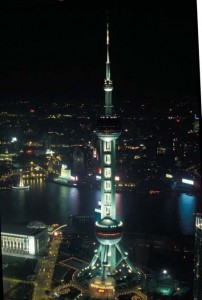 Shanghai´s modern skyline would be recognised immediately by Buck Rogers: its soaring and preposterously capped skyscrapers look like they’ve been designed en masse by a comic-book illustrator from the 1950s. It is, quite simply, a twenty-first-century futurama of architecture that is both beautiful and ugly. Nothing epitomises this better than the Oriental Pearl TV Tower – a building of such cartoonish proportions that it looks set to take off once its engines are warmed up. The equally outlandish Grand Hyatt Hotel, in the Jinmao tower, might also be preparing for countdown. This sci-fi hostelry has an iconic atrium that soars more than 30 stories: but rather than elicit architectural awe, I found the vertiginous drop nauseous. A head for heights is essential in this brave new world. At night the city becomes even more futuristic. Electronic billboards 50 storeys high radiate colossal messages to the 22 million people down below. Skyscrapers attempt to outshine each other with super-lurid illuminations, and their constant fluorescent blinking puts Piccadilly Circus and Times Square to shame. Even though the city is so vast, it’s easy to get the hang of Shanghai. The aerial roads that interlace it are more super-highways than flyovers, and offer an oddly detached view of the busy streets below.
Shanghai´s modern skyline would be recognised immediately by Buck Rogers: its soaring and preposterously capped skyscrapers look like they’ve been designed en masse by a comic-book illustrator from the 1950s. It is, quite simply, a twenty-first-century futurama of architecture that is both beautiful and ugly. Nothing epitomises this better than the Oriental Pearl TV Tower – a building of such cartoonish proportions that it looks set to take off once its engines are warmed up. The equally outlandish Grand Hyatt Hotel, in the Jinmao tower, might also be preparing for countdown. This sci-fi hostelry has an iconic atrium that soars more than 30 stories: but rather than elicit architectural awe, I found the vertiginous drop nauseous. A head for heights is essential in this brave new world. At night the city becomes even more futuristic. Electronic billboards 50 storeys high radiate colossal messages to the 22 million people down below. Skyscrapers attempt to outshine each other with super-lurid illuminations, and their constant fluorescent blinking puts Piccadilly Circus and Times Square to shame. Even though the city is so vast, it’s easy to get the hang of Shanghai. The aerial roads that interlace it are more super-highways than flyovers, and offer an oddly detached view of the busy streets below.
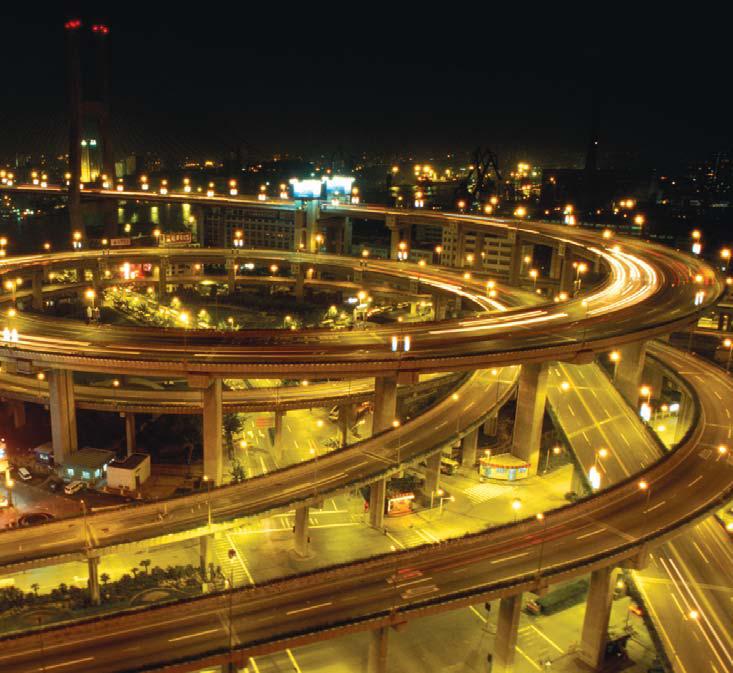 The immense Nanpu Bridge curls like a giant watch-spring on each side of Shanghai’s main artery (it is the only span that crosses the Huangpu River). A garish tourist tunnel on the Bund promises all sorts of silly adventure underneath the water: but instead I took the commuter ferry for two yuan (somewhere in the region of seven pence) across the water, and marvelled at the sheer scale of this place. It struck me that the city is essentially about contrast: day and night, extraordinary wealth and solid utility. Neon-lit massage parlours and beauty salons in the French Quarter evoked a seediness and decadence that I found enticing. Blind masseurs gave an agonising foot massage for just a few pounds; while in the Saladin Club, rent boys played cards and vied for an altogether more expensive trade. Outside, broad avenues, narrow streets and winding alleys belong to the romantic Shanghai of the 1930s that Charlie Chaplain and Noel Coward would have known. Art deco mansions and occasional Edwardian suburban houses, left by expats decades ago, looked faintly incongruous. Laundry tied between balconies and trees on criss-crossed sticks was like so many fabric mobiles, and the complicated webbing of phonewires and electric tram cables only added to the glorious visual confusion. Perhaps fusion is the key. I saw a Prosperity God beaming from a shop window: but this golden statue owed as much to Father Christmas’s well-padded figure as to more local styles. Here two distinct cultures were simultaneously (if unintentionally) encapsulated – East and West – in a God for all seasons.
The immense Nanpu Bridge curls like a giant watch-spring on each side of Shanghai’s main artery (it is the only span that crosses the Huangpu River). A garish tourist tunnel on the Bund promises all sorts of silly adventure underneath the water: but instead I took the commuter ferry for two yuan (somewhere in the region of seven pence) across the water, and marvelled at the sheer scale of this place. It struck me that the city is essentially about contrast: day and night, extraordinary wealth and solid utility. Neon-lit massage parlours and beauty salons in the French Quarter evoked a seediness and decadence that I found enticing. Blind masseurs gave an agonising foot massage for just a few pounds; while in the Saladin Club, rent boys played cards and vied for an altogether more expensive trade. Outside, broad avenues, narrow streets and winding alleys belong to the romantic Shanghai of the 1930s that Charlie Chaplain and Noel Coward would have known. Art deco mansions and occasional Edwardian suburban houses, left by expats decades ago, looked faintly incongruous. Laundry tied between balconies and trees on criss-crossed sticks was like so many fabric mobiles, and the complicated webbing of phonewires and electric tram cables only added to the glorious visual confusion. Perhaps fusion is the key. I saw a Prosperity God beaming from a shop window: but this golden statue owed as much to Father Christmas’s well-padded figure as to more local styles. Here two distinct cultures were simultaneously (if unintentionally) encapsulated – East and West – in a God for all seasons.
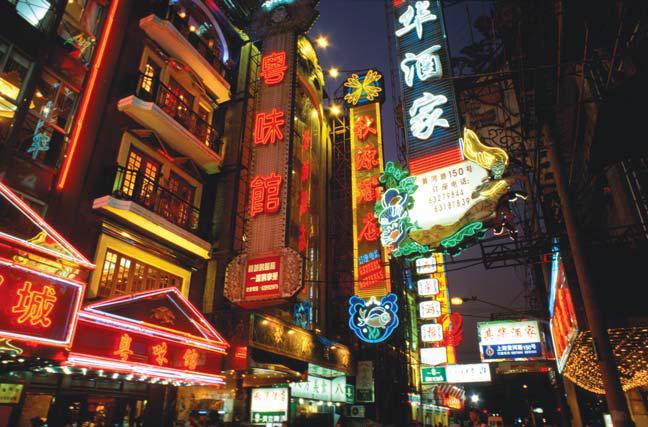 Likewise, urban fashions embrace the latest in microfibre sportswear and traditional silk cheongsams: the girls in Shanghai look sleek and chic in both. Some sport punkish hairstyles, others classical black bobs. Beneath the bright lights, but still central to the city, is Yuyuan district, another intriguing ward in this charismatic sprawl, and something of a time slip. Here the lights are dim and byways mysterious. I sat in a simple steam-food restaurant packed with locals, and feasted from an aluminium cauldron filled with chilli chicken. As I neared the bottom of the pot, a child topped it up with hot water, making a soup into which I threw mushrooms, herbs and noodles. A bottle of Beijing Two Pot – liquor that is a startling 55 per cent proof – was the perfect, if somewhat potent accompaniment to a meal that cost not much more than a pound. I stumbled back to my hotel, another exotic cloud-grazer near the Bund. The Westin Shanghai typifies this city of extremes. Its enormous cantilevered glass staircase dominates acres of marble flooring in the lobby, which is a place staffed with improbably beautiful people. Cocooned on the twenty-sixth floor in understated luxury, I imagined an origami expert had made up the bed and a feng shui specialist had arranged my tatty luggage exquisitely on the low mahogany table. This is the type of glamour that only serious money can buy. It would cost something in the region of a month-and-a-half’s typical salary (about 5,000 yuan) for an ordinary Shanghai resident to stay here for one night. The Fake Market still continues to ply its designer contraband.
Likewise, urban fashions embrace the latest in microfibre sportswear and traditional silk cheongsams: the girls in Shanghai look sleek and chic in both. Some sport punkish hairstyles, others classical black bobs. Beneath the bright lights, but still central to the city, is Yuyuan district, another intriguing ward in this charismatic sprawl, and something of a time slip. Here the lights are dim and byways mysterious. I sat in a simple steam-food restaurant packed with locals, and feasted from an aluminium cauldron filled with chilli chicken. As I neared the bottom of the pot, a child topped it up with hot water, making a soup into which I threw mushrooms, herbs and noodles. A bottle of Beijing Two Pot – liquor that is a startling 55 per cent proof – was the perfect, if somewhat potent accompaniment to a meal that cost not much more than a pound. I stumbled back to my hotel, another exotic cloud-grazer near the Bund. The Westin Shanghai typifies this city of extremes. Its enormous cantilevered glass staircase dominates acres of marble flooring in the lobby, which is a place staffed with improbably beautiful people. Cocooned on the twenty-sixth floor in understated luxury, I imagined an origami expert had made up the bed and a feng shui specialist had arranged my tatty luggage exquisitely on the low mahogany table. This is the type of glamour that only serious money can buy. It would cost something in the region of a month-and-a-half’s typical salary (about 5,000 yuan) for an ordinary Shanghai resident to stay here for one night. The Fake Market still continues to ply its designer contraband.
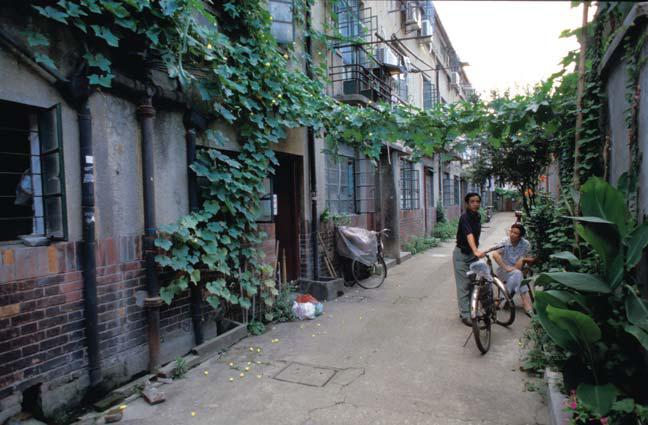 Even though the superpowered luxury-goods conglomerates have threatened to bankrupt the traders and close the place down, here racketeering flourishes. The amazing hustle and hassle of the placewas punctuated by surreptitious petitions – “Watches, bags, DVDs?” – which became a constant mantra from spivs clad in dodgy Burberry macs. Mont Blanc pens were sold wholesale – a fiver could bag you a dozen –and bogus Gucci sunglasses were virtually given away. One enterprising old man attempted to drag me to his stall, muttering: “Ming dynasty, cheapy-cheap.” It was hard to resist such blatant chicanery. But no visit to this exciting uber-city would be complete without a trip on the Germandesigned and Chinese-built Maglev (short for Magnetic Levitation Railway). This is the fastest commercially operated train on the planet,
Even though the superpowered luxury-goods conglomerates have threatened to bankrupt the traders and close the place down, here racketeering flourishes. The amazing hustle and hassle of the placewas punctuated by surreptitious petitions – “Watches, bags, DVDs?” – which became a constant mantra from spivs clad in dodgy Burberry macs. Mont Blanc pens were sold wholesale – a fiver could bag you a dozen –and bogus Gucci sunglasses were virtually given away. One enterprising old man attempted to drag me to his stall, muttering: “Ming dynasty, cheapy-cheap.” It was hard to resist such blatant chicanery. But no visit to this exciting uber-city would be complete without a trip on the Germandesigned and Chinese-built Maglev (short for Magnetic Levitation Railway). This is the fastest commercially operated train on the planet,
whisking passengers from the airport at over 430 kilometres per hour, in a little under eight minutes. I met one man who regularly took a taxi to the airport just so he could take the space-age ride back into town.
After all of this, London felt crushingly Third-World on my return.
Where to stay
Shanghai Top sites
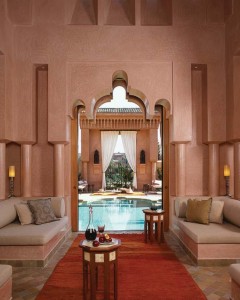 The Aman Resorts are famous for their unparalleled service , beauty, tranquillity and luxury.Marrakech’s own Aman resort,the Amanjena, lives up to its name:Amanjena means ‘peaceful paradise’. The resort’s wonderful design – taking inspiration from traditional architecture using Marrakech’s famous pink-coloured stone and plenty of waterways and reflecting pools – certainly fulfils all the above criteria. The Amanjena spa also takes inspiration from local tradition. Morocco is famous for its hammams – public baths in which you are steamed and scrubbed to a healthy glow. The spa here has, as well as all the treatments you would expect,hammams that can be combined with every treatment. Each hammam (one for men and one for women) has its own showers,washrooms, a changing area and a glassed-in whirlpool in which to soak afterwards if you wish. The hammams are beyond beautiful,shimmering with blue irridescent tiles arranged like fish scales, and with enough room to house a family of 12.
The Aman Resorts are famous for their unparalleled service , beauty, tranquillity and luxury.Marrakech’s own Aman resort,the Amanjena, lives up to its name:Amanjena means ‘peaceful paradise’. The resort’s wonderful design – taking inspiration from traditional architecture using Marrakech’s famous pink-coloured stone and plenty of waterways and reflecting pools – certainly fulfils all the above criteria. The Amanjena spa also takes inspiration from local tradition. Morocco is famous for its hammams – public baths in which you are steamed and scrubbed to a healthy glow. The spa here has, as well as all the treatments you would expect,hammams that can be combined with every treatment. Each hammam (one for men and one for women) has its own showers,washrooms, a changing area and a glassed-in whirlpool in which to soak afterwards if you wish. The hammams are beyond beautiful,shimmering with blue irridescent tiles arranged like fish scales, and with enough room to house a family of 12.
A therapist comes in with you, to administer the gommage (scrub) when you have steamed for long enough for your pores to open. Then a clay mask is applied, and finally lavender and rose water wash it all off – after which your skin will be softer than when you were born. Afterwards, I opted for a massage with rose oil to further soften the skin and unravel my tight muscles. After a blissful two-and-a-half-hours in total, I floated into my private whirlpool to bring myself slowly back to reality. It’s a world-class experience, among the very best in Morocco.
 This must be the most chaotic corner of Cochin: a bus station, a bazaar, a ferry terminal, all within yards of each other – people on, people off, shopping, shouting, a tumultuous clamour of calls and bangs and engines revving up. Dodging the crowds, almost staggering under the heat, I go a little way up a dirt road, dust rising at my feet and sinking into my sandals. As rickshaws speed past and goats prance around potholes, I turn into a cobbled courtyard and, instantly, peace and calm settle around me like a soft shawl. It’s a home-at-last feeling. Although Brunton Boatyard is a grand sort of home, it’s a homely sort of hotel. I’m crumpled and hot and frankly grubby, but it could not matter less. Here, right on the edge of the everyday hustle of Cochin, is a haven. A cold and lemony drink appears as I flop into a vast seat in the airy foyer. Vaulting arches let in swathes of sunlight from another courtyard, this one all grassy and lush, sheltering a huge Rain Tree and full of birdsong. Old fashioned fans – punkahs – hang from a high, carved, wooden ceiling. My feet yearn to slip out of the now scratchy sandals and on to the smooth, cool, tiled floor.All the building materials used here have that tactile, soothing quality – walls bright white with limewash, warm dark wood, terracotta floors. The Old Colonial style creates a sense of timeless tranquillity. But Brunton is a very new hotel: building work began in 1999. For a century before that, the site was home to a bustling boatyard, as full of noise and action as it now is with peace and relaxation.
This must be the most chaotic corner of Cochin: a bus station, a bazaar, a ferry terminal, all within yards of each other – people on, people off, shopping, shouting, a tumultuous clamour of calls and bangs and engines revving up. Dodging the crowds, almost staggering under the heat, I go a little way up a dirt road, dust rising at my feet and sinking into my sandals. As rickshaws speed past and goats prance around potholes, I turn into a cobbled courtyard and, instantly, peace and calm settle around me like a soft shawl. It’s a home-at-last feeling. Although Brunton Boatyard is a grand sort of home, it’s a homely sort of hotel. I’m crumpled and hot and frankly grubby, but it could not matter less. Here, right on the edge of the everyday hustle of Cochin, is a haven. A cold and lemony drink appears as I flop into a vast seat in the airy foyer. Vaulting arches let in swathes of sunlight from another courtyard, this one all grassy and lush, sheltering a huge Rain Tree and full of birdsong. Old fashioned fans – punkahs – hang from a high, carved, wooden ceiling. My feet yearn to slip out of the now scratchy sandals and on to the smooth, cool, tiled floor.All the building materials used here have that tactile, soothing quality – walls bright white with limewash, warm dark wood, terracotta floors. The Old Colonial style creates a sense of timeless tranquillity. But Brunton is a very new hotel: building work began in 1999. For a century before that, the site was home to a bustling boatyard, as full of noise and action as it now is with peace and relaxation.
An ancient anchor lying on the lawn marks this nautical past; but even without it, there’s no escaping from boats. Brunton is on Cochin’s harbour front. Freighters and ferries, ships and sailing boats are part of the view. From the hotel’s own jetty – which is a lovely spot for a sundowner – guests can see the graceful curves of traditional Chinese fishing nets silhouetted against the sky, and count the fish lying in small fishing boats floating past. Even when you’re engaged in some solitary indulgence – enjoying lazy laps in the silky water of the green pool, lying on a lounger soaking up the sun – ships and boats bobbing past make your mood sociable. And every one of the 22 rooms boasts a sea-view: so after easing into a warm bath, or climbing into one of the giant antique four-posters, it is possible to look out of the window at any given moment to see the world sailing by. There are boats at dawn and also at dusk. Late in the evening, strolling on to the terrace for a last communion with the sea breeze and the stars, I hear a ferry bumping against the jetty. I turn to see passengers disembarking, laughing, picking up a snack at the bazaar, before they head for home on the last bus.
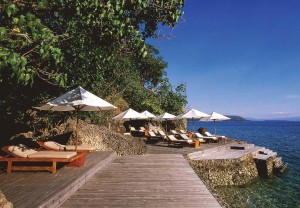 It´s a long hop, skip and hump to get all the way to Amanwana resort on Moyo island. A flight from Bali to Lombok, another one to Sumbawa, and then an hour by boat. All this, just to get to some tents on a jungle-covered island. I have doubts. But when the resort boat turns up, it’s a cruiser, and the champagne flows as we skip over the blue-black shades of immensely deep sea. Flying fish leap alongside, the spray left in our wake sparkles in the sun, we’re in the middle of nowhere – which always gives me a heady rush – and I begin to think that the tents might be alright after all. And they are. There are just 12 of them, each at the end of a winding sandy path. Some are by the beach, others strewn under the canopy of a deep and lush jungle. They are all utterly luxurious, in the best way – understated, elegant and deeply comfortable. Each has a polished floor of smooth hardwood, a king-size bed and a state of the art bathroom. These are not shaky canvas ridge-tents pitched by woggle-wearers, they’re more like marquees with walls. In each tent, a sitting area is adorned with Indonesian carvings or other artworks and lined with vast divans – perfect for lazing or for gazing through the huge windows. These present the only sort of difficulty here – which view to choose: the varied greens of unspoilt tropical jungle, or the changing blues of the Flores Sea?
It´s a long hop, skip and hump to get all the way to Amanwana resort on Moyo island. A flight from Bali to Lombok, another one to Sumbawa, and then an hour by boat. All this, just to get to some tents on a jungle-covered island. I have doubts. But when the resort boat turns up, it’s a cruiser, and the champagne flows as we skip over the blue-black shades of immensely deep sea. Flying fish leap alongside, the spray left in our wake sparkles in the sun, we’re in the middle of nowhere – which always gives me a heady rush – and I begin to think that the tents might be alright after all. And they are. There are just 12 of them, each at the end of a winding sandy path. Some are by the beach, others strewn under the canopy of a deep and lush jungle. They are all utterly luxurious, in the best way – understated, elegant and deeply comfortable. Each has a polished floor of smooth hardwood, a king-size bed and a state of the art bathroom. These are not shaky canvas ridge-tents pitched by woggle-wearers, they’re more like marquees with walls. In each tent, a sitting area is adorned with Indonesian carvings or other artworks and lined with vast divans – perfect for lazing or for gazing through the huge windows. These present the only sort of difficulty here – which view to choose: the varied greens of unspoilt tropical jungle, or the changing blues of the Flores Sea?
It’s a hard call. Everything else is easy. The staff are so sussed, the surroundings so seductive, that it’s impossible not to feel pampered, even without visiting the massage area under tamarind trees just off the beach. Mind you, some Amanwana activities make a massage a good idea at the end of your day. There are hikes deep into the forest, to see deer, monkeys, wild boars and a series of waterfalls that cascade into terraced pools. Then there’s diving and snorkelling off the beach. Just metres from the shore, the reef wall falls away so suddenly and steeply that you feel as though you are falling through space into another world. Behind you the water is warm and clear: ahead chilly indigo depths beckon, home to sharks, rays, turtles and flamboyant fish. Beyond that, there’s deep-sea fishing, on a boat that rocks as a feisty black marlin ducks and dives, determined not to hit the deck. It is released as soon as the long fight is over. But a smaller tuna is taken ashore, to the open-air pavilion that is our restaurant, and served up as the freshest, finest sashimi. All these activities merit a massage as the sun begins to fade out. And the person who created this retreat merits a medal.
Ever since the days of aphrodite, Cyprus has been a home to beauty, love and laughter.Yet one empire or another dominated this third-largest Mediterranean island until 1960,when the British finally ceded control.Tensions between the island’s Orthodox Christian Greek and Muslim Turkish communities soon flared,until the island was divided in 1974.Today,calm has returned, and with it, those old qualities of beauty, love and laughter are more prominent than ever. Of the southern,Greek-controlled,portion of the island, it’s the north coast that has most recently been developed for tourism. Here the Anassa Hotel perches on a hillside, just outside of Latchi, moments from the water’s edge. From afar, the complex looks like a traditional Greek village – all whitewashed villas and terracotta-tiled roofs, complete with its own Byzantine-style church. Opened in 1999, the hotel, for all its traditional styling,is awash with modernity.The cool, airy rooms are filled with all the usual mod-cons and king-sized beds, while each has its own private balcony looking over the fragrant gardens or out across the infinity pools to the sea and an unblemished horizon. The marble bathrooms are a generous size, with space for a bath and walk-in shower.Some rooms allow the bather to look out of their windows to the sea beyond,while others have small whirlpools on their private terraces,perfect for that late-evening romantic dip. Unsurprisingly, these rooms are known as the Aphrodite and the Adonis. Off the marble-floored main stairway are a choice of restaurants and bars,offering everything from silver service to a buffet selection. A quieter,more secluded restaurant, limited to 20 or so diners,offers the full gourmet experience.
Away from the main building are a number of low-lying small villas. Guests staying here are welcome to visit the bars and restaurants of the main building, and to mingle with the other guests around the infinity pools,but these villas are totally selfcontained should they wish not to – and some even include their own private infinity pool. For a five-star and award-winning hotel however, the spa at Anassa is not quite up to standard. While it’s always pleasant to spend time in a hotel spa, this one is just a little rough around the edges – with a concrete,rather than tiled,surround to the pool, a rather small sauna with a pokey changing area,and an uncomfortable jet pool. Elsewhere in the Thanos Hotels stable is the Almyra, in Paphos on the south coast.This smaller hotel has recently been refurbished and its spa facilities are still under construction – though this does not impact on guests. The Almyra features a much more minimalist and modern feel, offering simple rooms with bespoke furnishings and an emphasis on making the most of the stunning view.Some rooms have private terraces just a stone’s throw from the water,others a small balcony, and those that can’t have either do benefit from floor-to-ceiling windows that slide fully open,making the room itself feel like a balcony. Those rooms in a separate complex offer private roof terraces, from which you can survey the hotel grounds – eight acres of landscaped garden, the freshwater pool and views across the bay towards the harbour of Paphos.
Like Paphos itself, this ultra-chic modernist hotel comes with personality.This is the hotel that Blofeld would build, should he ever give up being a criminal mastermind to become a hotelier. But I do believe he’d have chosen to make some changes to the immediate surroundings. Because this hotel is not quite as all-encompassing as the Anassa, guests may well want to go exploring.But just across the road is a strip of tacky bars and restaurants, the first of which advertises itself in big bold letters as a topless bar – which is not perhaps the first thing you want to see when leaving a family hotel. That aside, both hotels do offer fantastic facilities for families with small children.Their Baby Go Lightly service means that guests can leave home unencumbered,having requested the hotel staff to supply them with nappies,pushchairs,monitors, bottles and colouring books as necessary.Furthermore,swimming and tennis lessons can also be booked for older children, to give the parents some welcome respite. For they too will find,at these sister hotels,plenty of the beauty, love and laughter that Cyprus has hung onto during its often difficult history.Paphos is after all, the legendary birthplace of Aphrodite.
Almyra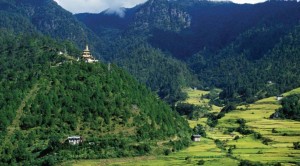 Surrounded by blue pine forests in the hills overlooking a lush valley in the secluded Himalayan kingdom of Bhutan is a hotel – literally – fit for a king. The Olathang, on the outskirts of the town of Paro, was built in 1974 for guests invited to the coronation of His Majesty King Jigme Singye Wangchuk. The occasion marked the first time that Bhutan’s doors were opened to the world. As 287 foreigners arrived in a little-known land unused to visitors, several new hotels were constructed to accommodate them. The Olathang was among them. Sprawling over 45 acres of wooded land, this is Bhutan’s largest hotel and one of its best. Its white, fortress-like structure has 24 rooms and 6 suites in the main building, which also houses the reception areas, restaurant and bar. But the best accommodation is in 32 traditionally built wooden cottages dotted around the grounds. These elegant sugar-cubed cottages – rather like Swiss chalets – are beautifully decorated with various symbolic patterns including the national flower (the blue poppy) and the eight auspicious signs of Himalayan Buddhism. Their whitewashed walls contrast with dark wooden rafters, while bright murals emphasise the balance between secular and spiritual worlds that is integral to Bhutanese society. One design shows the male and female dragons that give the country its local name, Druk Yul – the thunder dragon. These clean and cosy en suite rooms have Western-style bathrooms and warm, comfortable beds ideal for uninterrupted slumber after days of hard trekking.
Surrounded by blue pine forests in the hills overlooking a lush valley in the secluded Himalayan kingdom of Bhutan is a hotel – literally – fit for a king. The Olathang, on the outskirts of the town of Paro, was built in 1974 for guests invited to the coronation of His Majesty King Jigme Singye Wangchuk. The occasion marked the first time that Bhutan’s doors were opened to the world. As 287 foreigners arrived in a little-known land unused to visitors, several new hotels were constructed to accommodate them. The Olathang was among them. Sprawling over 45 acres of wooded land, this is Bhutan’s largest hotel and one of its best. Its white, fortress-like structure has 24 rooms and 6 suites in the main building, which also houses the reception areas, restaurant and bar. But the best accommodation is in 32 traditionally built wooden cottages dotted around the grounds. These elegant sugar-cubed cottages – rather like Swiss chalets – are beautifully decorated with various symbolic patterns including the national flower (the blue poppy) and the eight auspicious signs of Himalayan Buddhism. Their whitewashed walls contrast with dark wooden rafters, while bright murals emphasise the balance between secular and spiritual worlds that is integral to Bhutanese society. One design shows the male and female dragons that give the country its local name, Druk Yul – the thunder dragon. These clean and cosy en suite rooms have Western-style bathrooms and warm, comfortable beds ideal for uninterrupted slumber after days of hard trekking.
They also offer necessary sanctuary from the unpredictable mountain weather. But their most impressive feature is their balcony, a great place to enjoy the pure air and wispy silence of the enchanting Paro valley below. Through the pines you’ll catch a breathtaking view of snow-capped peaks sweeping down to verdant paddy fields planted like patchwork along the fertile valley floor. Clumped farmsteads, reminiscent of Japanese temples, dot the horizon, and willow trees line the banks of the Paro River. Dominating the skyline are the mighty dzongs, sturdy fortress-monasteries built to protect the country from enemies long ago. To reinforce the feeling that Bhutan has one foot in the past and one in the future, you can wander back into the main building and see members of the hotel staff dressed in traditional Bhutanese costume. But this is not a tourist gimmick: the male gho and female kira are still worn throughout the kingdom. The Olathang will never score highly on international hotel ratings, but it’s a great place to sample this special country. It’s authentic, charming and luxurious. And in terms of setting, you’d be hard pushed to beat it. As the king who opened his country to the world once said: “I am not as much concerned by the Gross National Product, as I am about the Gross National Happiness.”